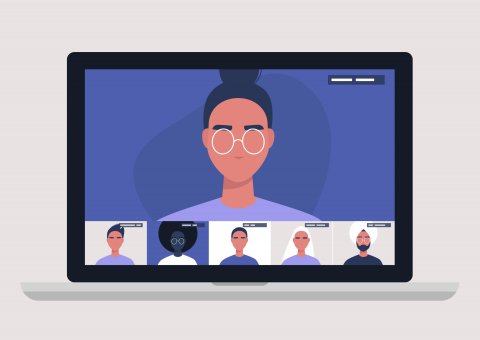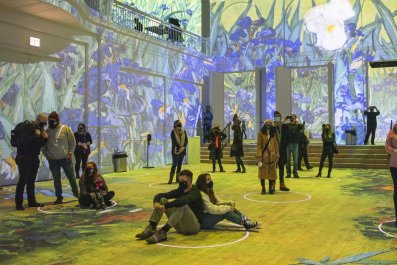Since the sudden onset of lockdowns and remote work a year ago, reliance on digital platforms has grown exponentially. For example, Zoom Video Communications' revenue in 2020 was $622.7 million, up 88 percent from the previous year. Despite the myriad benefits from videoconferencing platforms, the psychological effects of "Zoom fatigue" can be detrimental, as discussed in a study published in February by Stanford researchers in the journal Technology, Mind and Behavior, in which four main causes of exhaustion caused by teleconferencing are identified. Communications guru and consultant Susan McPherson shares how to make the most of digital conferencing platforms in the excerpt below from her new book The Lost Art of Connecting (McGraw-Hill, March). At a time when people feel so disconnected from one another, McPherson's advice for fostering business relationships is essential.

Fran Hauser is a startup investor and advisor, funding and advising consumer-focused companies. Formerly digital president for Time Inc.'s Style and Entertainment Group, she is also a philanthropist and advocate for women in business. For virtual meetings, in order to make them a bit more personal and connected, Hauser recommends starting the meeting by following up on something someone said in the last call. For example, "How did that client pitch go, Susan?" Or if it's not a recurring meeting, see if you can find something else to ask about right off the bat. Was there a local event that transpired where that person lives that you could ask about?
Hauser points out that all of us—no matter what position we're in, no matter what the nature of the business relationship—need to feel seen and psychologically safe. Hauser shared with me that she feels this is extremely important. In fact, in 2016, Google conducted research to find out what created the best "teams." They wanted to find out: What makes teams productive? It was believed that they might find the best teams were those with the brightest members or the people who are agile thinkers in intense situations. But that's not at all what they found. Instead, what Google's research on teams turned up was that the most effective teams were the ones that created the most psychological safety. When team members felt seen and heard, they performed better. And since digital or virtual meetings like those on Zoom and Hangouts can feel more distant and less personal, Hauser's tip is a good one: circle back and let them know you were listening. In some way, let them feel seen and heard.
Other Ways to Cultivate Closeness Digitally
Michael Ronen, a creative director interested in the design of transformative, immersive experiences, wanted to explore how to create digital intimacy in the time of physical distancing. Alongside the Co-Reality Collective, Ronen developed a virtual party called Bodyssey to see if it was possible to cultivate closeness and deep connection while together virtually. What he learned is that for true intimacy to happen online, especially via virtual meeting technology, a group of about six people feels like the right number.
Ronen also found that there were many ways to foster digital intimacy. When you can't share the same physical space, there are other spaces that you can share: the same physical state (like moving to the same beat), a similar space (like looking outside at the moon), tasting the same food or drink or using the same or similar set of props or costumes. In some instances, using the physical space around you in your home, rather than blocking it out like you typically do on a Zoom call, can foster connections. If you're hosting the video call, you could ask each of your team members to meet in the "conference room," creating the sense that you are together. You could use the same Zoom background, for instance.
Creative uses of platforms like Bodyssey reveal how much room for innovation there is when we connect digitally and how when we create online gatherings thoughtfully, there's still much room for intimacy and deep connection.

Make the Most Out of Each Meeting
There are only 24 hours in a day no matter how you slice it. Yet most of us feel our time is increasingly scarce. Making the most of meeting times is a high priority. Whether you've decided to take the meeting in an online hashtag conversation or over coffee: prepare ahead of time. Take proactive steps to keep the conversation focused and appropriately brief. Remind yourself of your goal: Do you want to get a job interview? Do you desire a speaking opportunity? Do you want to get your new product reviewed by media? At the end of this particular meeting, what does success look like? Force yourself to answer that question. (If you don't know the answer, ask yourself why you set it up in the first place!)
Before the meeting, do some scenario planning: What if it doesn't go well? What if the conversation veers off course? What could you do to steer it back into a productive direction? Of course, you can't walk into a meeting with a robotic, prescriptive mindset and expect to have a fruitful relationship transpire. Look at these initial meetings as a learning opportunity and focus on the other person: What can I learn from them? As my late father always said: brevity is the key. You want to leave them wanting more. If your meeting, pitch or presentation is slated for 45 minutes, deliver 30 minutes of material and then offer 15 minutes for a Q&A discussion. Don't just spray information at the audience; they will want to participate, to interact and to engage. Always offer that—whether it's in a meeting or in a presentation. People sell themselves short when they have a big meeting with an important client and think, "I only have one shot."
But life doesn't work that way, right? If your internal voice during that conversation is saying, "I have to perform and impress this person," you won't be yourself. You'll be a nervous, anxious persona of the real you. But when you decide to cultivate a long-term relationship, you don't have to get everything accomplished in 45 minutes. You've got a lifetime to collaborate, to solve problems, to get to know each other better—and to make things happen.
Listen (No, Really)
Perhaps even more important than keeping the meeting or conversation brief, is to listen intensely while you are there. It sounds obvious to the point of absurdity. But human beings are notoriously bad at listening. Not only do we stink at it—we're not interested in it, either! A key distinction that most people overlook: listening and hearing are not the same thing. Hearing is connected to the old reptilian—Is that a tiger I hear?—part of the brain. Hearing works faster than vision and is very different than listening. Listening is the mental process of selecting things to pay attention to and then ascribing meaning to them. It's a skill. Ever heard of selective listening? Like when you ask someone to take out the trash but they claim, "I didn't hear you!" In truth, all listening is selective: we each retain sounds differently. We can walk out of the same conference with 500 other people with a diverging interpretation of what was shared. Each individual's listening is unique. Human beings listen through a set of filters, meaning that we ascribe different meaning to what we hear. If you consider how people listen, whether your audience is one person or a thousand, then you can hit the bull's-eye instead of missing the target altogether. It's about tuning into your audience and this notion of receiving information.
Dr. Julian Treasure, a sound and communication expert whose mission is to help people and organizations listen better and create healthier and more effective sound, including speaking says, "Listening is the doorway to understanding. It's very difficult to inspire people if you're not speaking appropriately to them." Of course, listening on Zoom or another digital platform is even more challenging than doing so in real life. In a virtual meeting, you're usually staring at your own face in addition to those of your colleagues or clients. (Is that spinach in my teeth?) You're also not as accountable: a quick text, a subtle email check—myriad escapes from a less-than-riveting presentation are within reach. Add to that the likelihood that a partner, child or roommate is also working from home—intent listening may well be a pipe dream! Hold yourself accountable, or at least make it harder to get pulled away: shut the door, leave your cell phone in another room, put the dog in a crate, leave a note for others that you are on a call and not to be interrupted and commit to listening fully.
Excerpt from The Lost Art of Connecting: The Gather, Ask, Do Method for Building Meaningful Business Relationships by Susan McPherson (McGraw Hill, March 2021).












